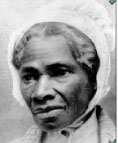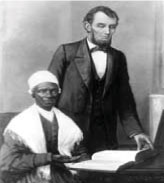Sojourner: Witness of Truth (Isabella Baumfree ~ 1797—1883)
The world didn’t know her as Sojourner Truth when she entered it in the late 1790’s. Born to slave parents, Isabella Baumfree, as was the name given to her, grew up on the Colonel Johannes Hardenbergh estate in Swartekill, in Ulster County, a Dutch settlement in New York - a state that allowed slavery until an emancipation decree was passed in 1827.
Isabella was one of thirteen children born to Elizabeth and James Baumfree, who were forced to live in the cramped, drafty cellars of their masters. Her earliest memories were of hardship and deprivation. She spoke Dutch until she was sold from her family around the age of 9. In 1808, John Neely purchased her along with a herd of sheep, for $100. Neely’s wife and family only spoke English and beat Isabella fiercely for the frequent miscommunications and because of this cruel treatment, she learned to speak English quickly. It was also during this time that she began to find refuge in religion and began her journey with God.
 |
Over the next few years, she was bought and sold by a succession of masters. Tired of the uncertainty that filled her life, Isabella decided to take action. With the help of her father (considered a free man as a result of illness) who interceded on her behalf to a tavern owner, she was purchased for $105. Although the work atmosphere was crude and morally questionable, it was a safer haven for her. But a year and a half later, in 1810, Isabella was once again sold to a new master in New York state, and continued to suffer many hardships.
Sometime around 1815, she fell in love with a fellow slave named Robert. Robert’s owner forbade the relationship because he did not want his slave having children with a slave he did not own. One night Robert visited Isabella, but was followed by his owner and son, who beat him savagely, bound him and dragged him away. Robert never returned. Isabella had a daughter shortly after, named Diana. In 1817, forced to submit to the will of a new owner, John Dumont, she married an older slave named Thomas. They had four children: Peter, James, Elizabeth and Sophia.
In 1799, the state of New York began to legislate the gradual abolition of slaves, which was to happen on July 4, 1827. Dumont had promised Isabella freedom a year before the state emancipation “if she would do well and be faithful.” However, he reneged on his promise, claiming a hand injury had made her less productive.
Isabella decided she could no longer live under these conditions. She began to make plans to escape with her infant daughter, Sophia, and was forced to leave her other children behind. In later years, she spoke of how God remained with her during this uncertain time, giving her direction and declared, “I did not run off, for I thought that wicked, but I walked off, believing that to be all right.”
 |
|
|
Sojourner Truth met with President Abraham Lincoln on October 29, 1864, when he showed her a Bible that was presented to him by the Black people of Baltimore, Maryland. |
During her flight to freedom, a Quaker couple, Isaac and Maria Van Wagenen, learned of her predicament and took her in until the state’s emancipation took effect. Because of the Van Wagenen’s benevolence, she began to learn what it meant to love those who had oppressed her and had a life-changing religious experience - becoming “overwhelmed with the greatness of the Divine presence”, and was inspired to preach.
Now that she was finally free, she moved to New York City and found work as a domestic servant and soon became active in a Methodist church. Later joining the African Methodist Episcopal denomination, she did volunteer social work helping former slaves. On June 1, 1843, she changed her name to ‘Sojourner [Traveler} Truth’ and told friends, “The Spirit calls me [East], and I must go. ...the Lord gave me Truth, because I was to declare the truth to the people.” She wandered in relative obscurity, depending on the kindness of strangers. In 1844, she joined the Northampton Association of Education and Industry in Massachusetts, founded by abolitionists to promote cooperative and productive labor. They were strongly anti-slavery, religiously tolerant, women’s rights supporters, and pacifist in principles. She began dictating her memoirs to Olive Gilbert, one of the Association’s members. The Narrative of Sojourner Truth: A Northern Slave was published privately in 1850 by William Lloyd Garrison. It gave her income and increased her speaking engagements. In 1854, at the Ohio Women’s Rights Convention in Akron, Ohio, she gave her most famous speech, with the legendary phrase, “Ain't I a Woman?”.
Sojourner was well into her 60s when the Civil War broke out, but she solicited supplies for the Union Army’s Black volunteer regiments. She met President Lincoln in 1864. She also served as a counselor in the national Freedmen’s Association for a year, helping emancipated slaves get established in the “new West.” She continued to teach and lecture after the war. When at last she retired, Sojourner moved to Battle Creek, Michigan, where she died on November 26, 1883. Isabella Baumfree not only left a given birth name behind, but also a magnificent legacy.
Excerpts taken from adaptations of “Great Women in American History”, by Rebecca Price Janney.






